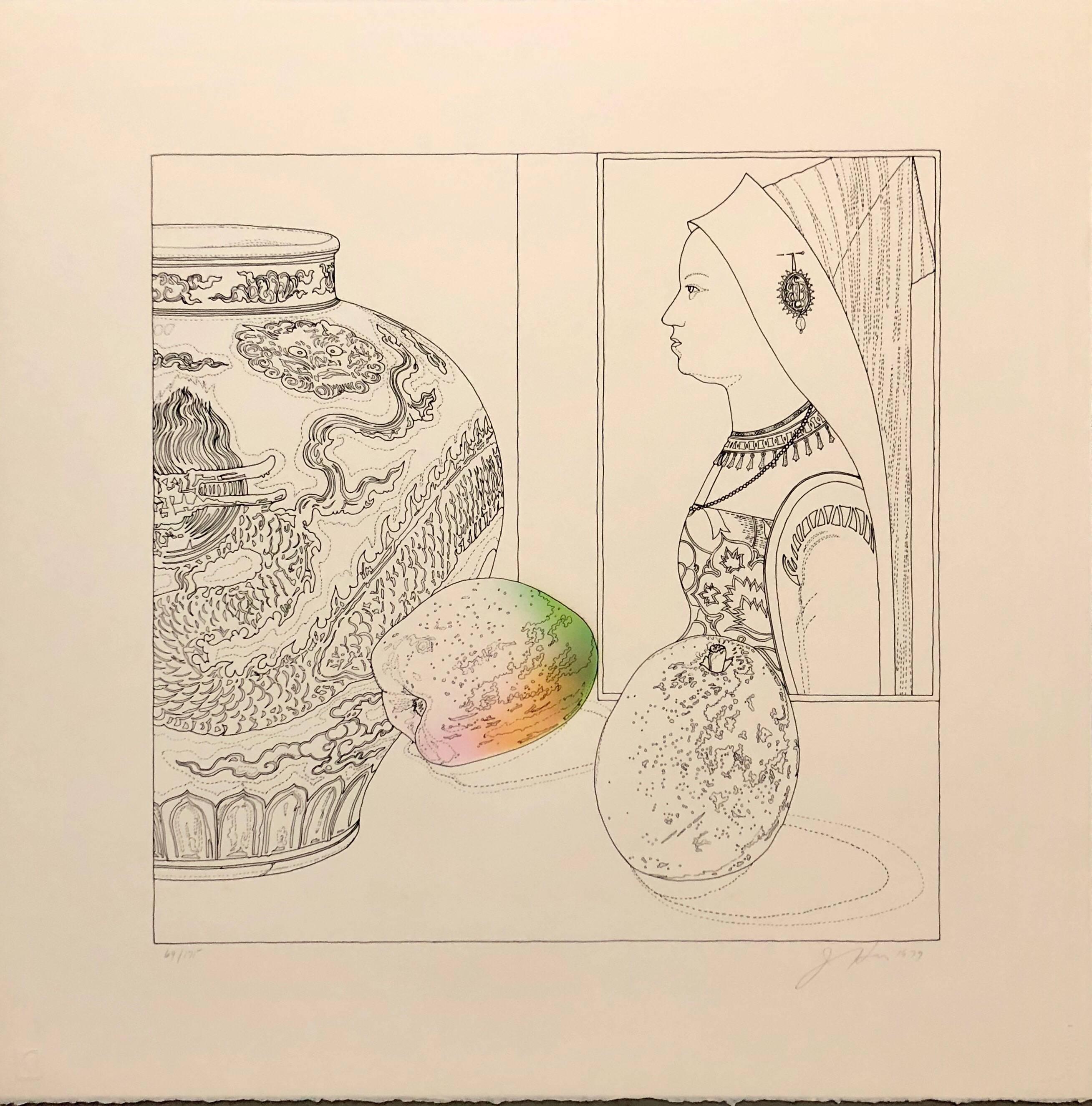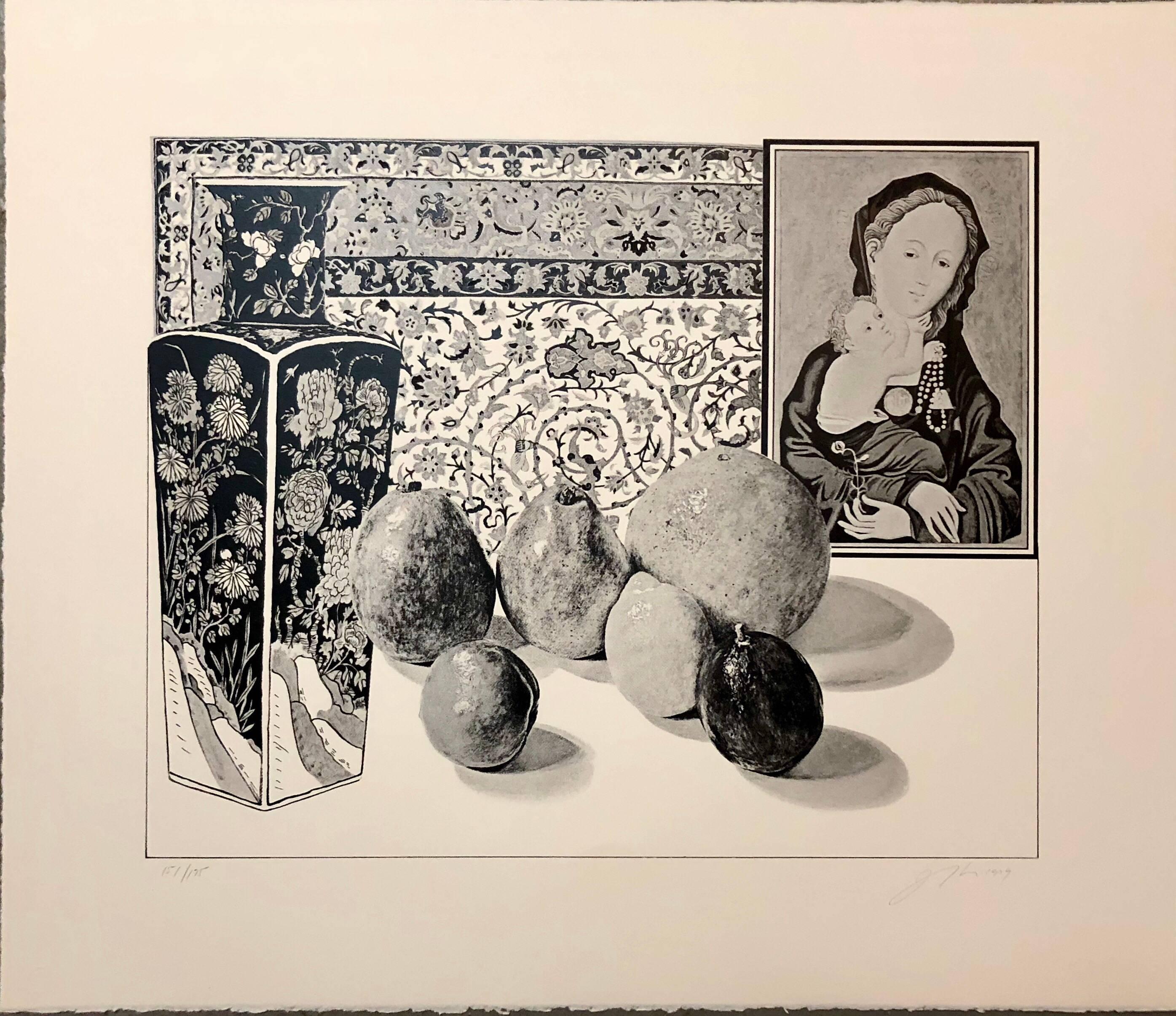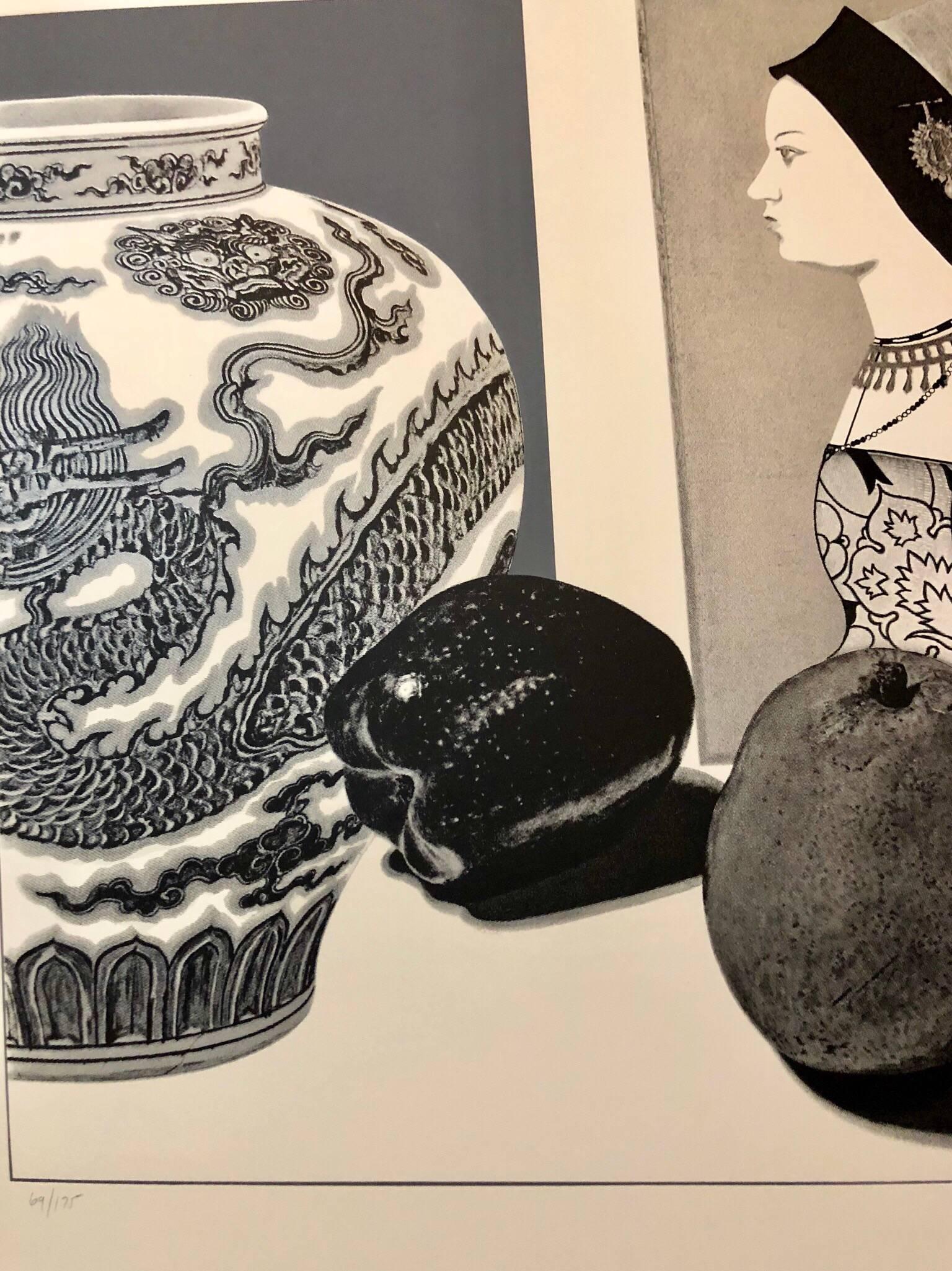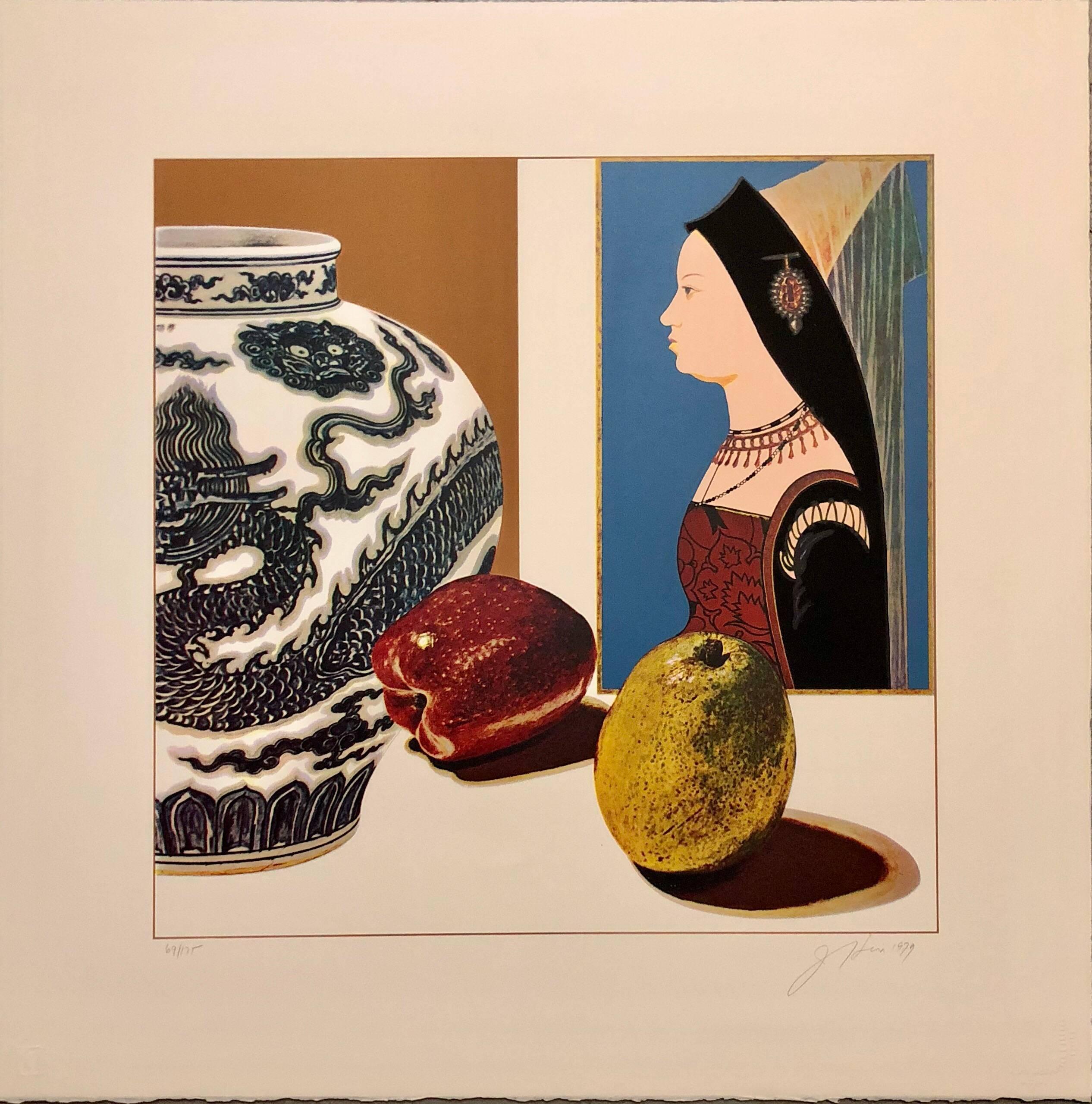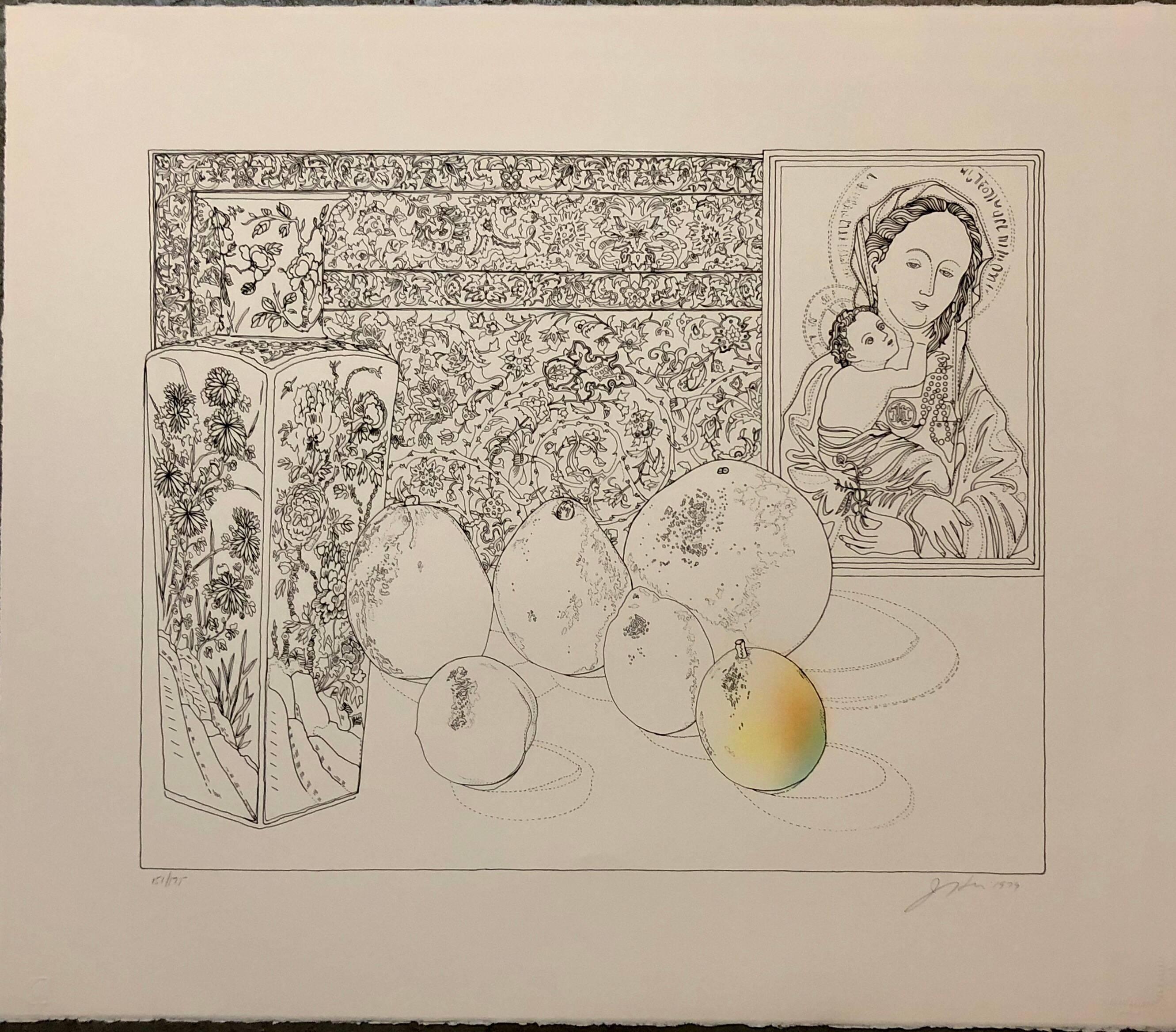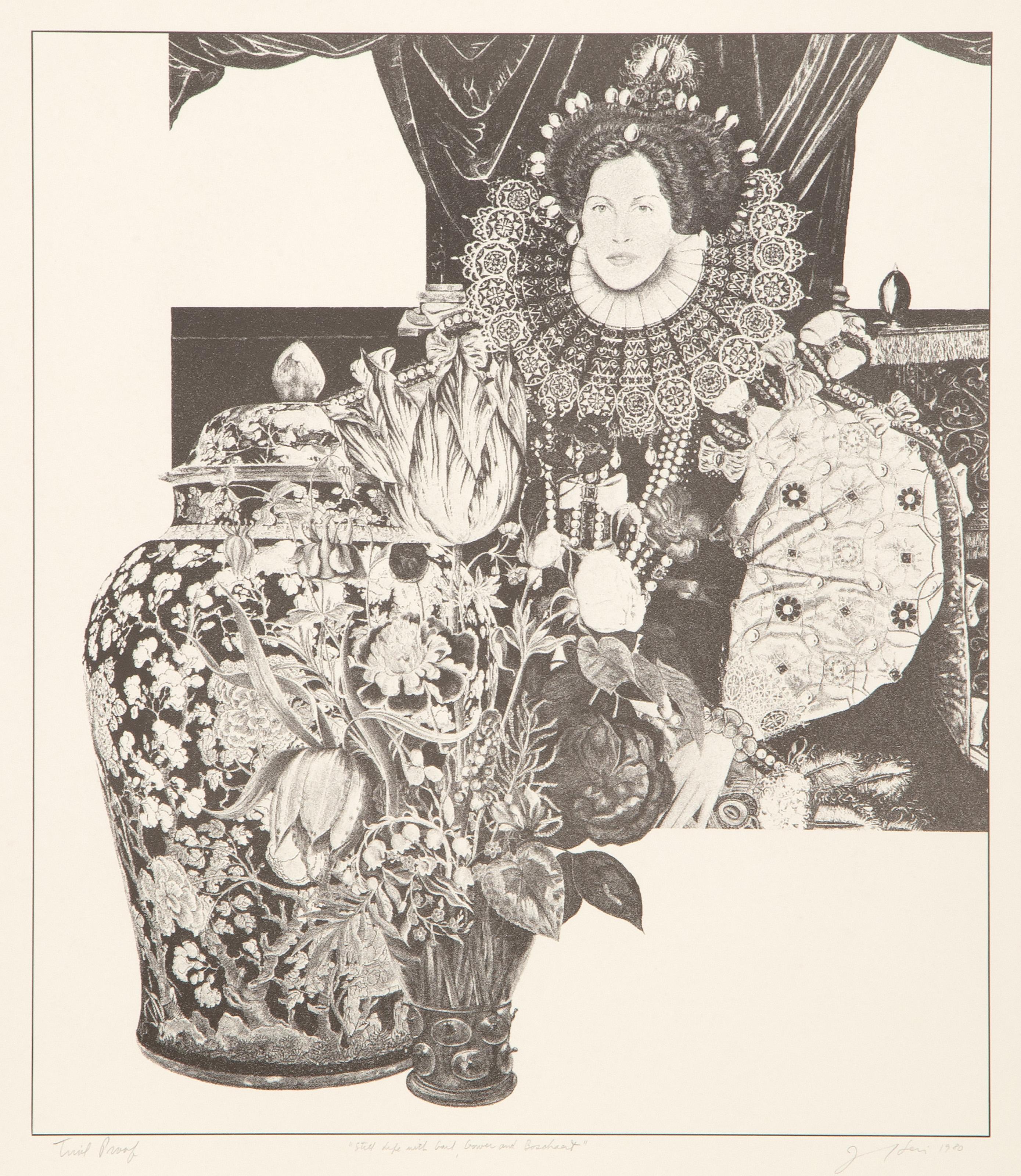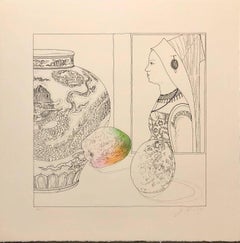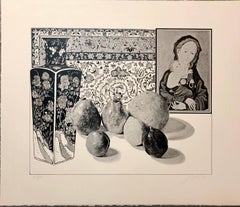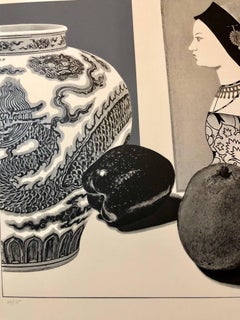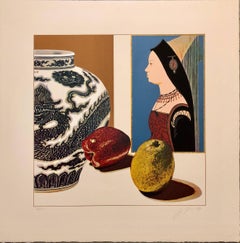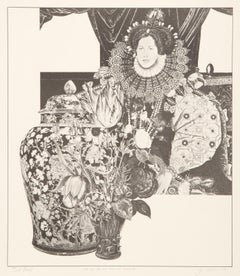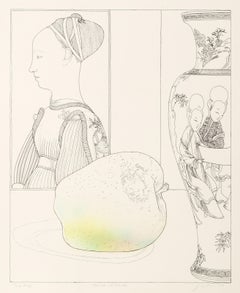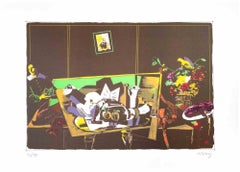Items Similar to Still Life with Sully and Warhol, Pop Art Mixed Media Signed Painting Drawing
Want more images or videos?
Request additional images or videos from the seller
1 of 15
Josef LeviStill Life with Sully and Warhol, Pop Art Mixed Media Signed Painting Drawing1994
1994
$2,250
£1,752.15
€1,993.07
CA$3,240.37
A$3,555.91
CHF 1,857.27
MX$42,514.82
NOK 23,525.59
SEK 21,942.04
DKK 14,885.40
About the Item
Still life with (thomas) Sully and (Andy) Warhol, (French actress Sarah Bernhardt (1844-1923))
Hand signed in pencil, dated 1994
bears gallery label from OK Harris Gallery in New York City
Josef Alan Levi (1938) is an American artist whose works range over a number of different styles, but which are unified by certain themes consistently present among them. Josef Levi began his artistic career in the 1960s and early '70s, producing highly abstract and very modernist pieces: these employing exotic materials such as light fixtures and metallic parts. By 1975, Levy had transitioned to painting and drawing still lifes. At first these were, traditionally, of mundane subjects. Later, he would depict images from art history, including figures originally created by the Old Masters. Around 1980, he made another important shift, this time toward creating highly precise, though subtly altered reproductions of pairs of female faces which were originally produced by other artists. It is perhaps this work for which he is most well known. Since around 2000, Josef Levi has changed the style of his work yet again: now he works entirely with computers, using digital techniques to abstract greatly from art history, and also from other sources.
Levi's works of art in the collections of the Museum of Modern Art, NYC, the National Gallery of Art, and the Albright-Knox Museum, among many others. Levi's art has been featured on the cover of Harper's Magazine twice, once in June 1987, and once in May 1997.
Josef Levi received a Bachelor of Arts degree in 1959 from the University of Connecticut, where he majored in fine arts and minored in literature. From 1959 to 1960, he served to a first lieutenant in the U.S. Army, and from 1960 through 1967 he was in the U.S. Army Reserves.
In 1966, he received the Purchase Award from the University of Illinois in 1966, and he was featured in New Talent U.S.A. by Art in America. He was an artist in residence at Appalachian State University in 1969, taught at Farleigh Dickenson University in 1971 and was a visiting professor of art at Pennsylvania State University in 1977. From 1975 to 2007, Levi resided in New York City. He now lives in an apartment in Rome, where he is able to paint with natural light as he was unable in New York.
From 1959 to 1960, Josef took some courses of Howard McParlin Davis and Meyer Schapiro at Columbia University which initiated him into the techniques of reproducing the works of the Old Masters. His first works, created in the 1960s, were wood and stone sculptures of women. His first mature works were abstract pieces, constructed of electric lights and steel.
In 1970, Levi's materials included fluorescent light bulbs, Rust-Oleum and perforated metal in addition to paint and canvas.
By 1980, Josef Levi's art had transformed into a very specific form: a combination of reproductions of female faces which were originally depicted by other artists. The faces which he reproduces may be derived from either portraits or from small portions of much larger works; they are taken from paintings of the Old Masters, Japanese ukiyo-e, and 20th-century art. Artists from whom he has borrowed include: Vermeer, Rembrandt, Piero della Francesca, Fernando Botero, Henri Matisse, Utamaro, Andy Warhol, Correggio, Da Vinci, Picasso, Chuck Close, Max Beckmann, Pisanello, Roy Lichtenstein. The creation of these works is informed by Levi's knowledge and study of art history.
Josef Levi's paintings from this period are drawn, then painted on fine linen canvas on wooden stretchers. The canvas is coated with twenty-five layers of gesso in order to produce a smooth surface on which to work. The drawing phase takes at least one month. Levi seals the drawing with acrylic varnish, and then he may apply layers of transparent acrylic in order to approximate the look of old paintings. After the last paint is applied, another layer of acrylic varnish is sprayed on to protect the work.
Most of the figures in his contemporary pieces are not paired with any others.
SELECTED COLLECTIONS
MUSEUM OF MODERN ART, NEW YORK, NY
ALBRIGHT- KNOX GALLERY, BUFFALO, NY
ALDRICH MUSEUM OF CONTEMPORARY ART, RIDGEFIELD, CT
NATIONAL GALLERY OF ART, WASHINGTON, DC
BROOKLYN MUSEUM OF ART, BROOKLYN, NY
SMITHSONIAN NATIONAL MUSEUM OF AMERICAN HISTORY, WASHINGTON, DC
CORCORAN GALLERY, WASHINGTON, DC
UNIVERSITY OF NOTRE DAME ART GALLERY, NOTRE DAME, IN
ARKANSAS ART CENTER, LITTLE ROCK, AR
HOOD MUSEUM OF ART, DARTMOUTH COLLEGE, HANOVER, NH
BANK OF NEW YORK, NEW YORK, NY
CHRYSLER CORPORATION, DETROIT, MI
EXXON CORPORATION, NEW YORK, NY
AT&T CORPORATION, NEW YORK, NY
BOWDOIN COLLEGE MUSEUM OF ART, BRUNSWICK, ME
NEW BRITAIN MUSEUM OF AMERICAN ART, NEW BRITAIN, CN
STORM KING ART CENTER, MOUNTAINVILLE, NY
YALE UNIVERSITY ART MUSEUM, NEW HAVEN, CT
- Creator:Josef Levi (1938, American)
- Creation Year:1994
- Dimensions:Height: 25.75 in (65.41 cm)Width: 33.25 in (84.46 cm)
- Medium:
- Movement & Style:
- Period:
- Condition:Outer folder is not included unless you buy all three. Prints are great. we have more than one so the number might be different than the photos.
- Gallery Location:Surfside, FL
- Reference Number:1stDibs: LU38214207722
Josef Levi
Josef Alan Levi (1938 – Present) Josef Alan Levi is an American artist, his works in the 1960s and early ‘70s were highly abstract and very modernist. He transitioned to painting and drawing still lifes. Mainly his work consisted of traditional, mundane subjects, then depicting images from art history, even including pieces originally created by the Old Masters. Levi has since shifted to creating highly precise, with subtly altered reproductions by other artists. This work is what is he most known for. The important themes seen throughout Levis work are the female form and the similarities in visual aesthetics. His works can be seen at the Museum of Modern Art, National Gallery of Art, among many others.
About the Seller
4.9
Platinum Seller
Premium sellers with a 4.7+ rating and 24-hour response times
Established in 1995
1stDibs seller since 2014
1,837 sales on 1stDibs
Typical response time: 1 hour
- ShippingRetrieving quote...Shipping from: Surfside, FL
- Return Policy
More From This Seller
View AllStill Life with Hans Maler Pop Art Serigraph Hand Signed
By Josef Levi
Located in Surfside, FL
On deckle edged watermarked Arches French paper. hand signed in pencil, dated and numbered. the edition size is 175.
there are three states of the same image image each with increasing detail and color. This is just for the one in the photo.
Josef Alan Levi (1938) is an American artist whose works range over a number of different styles, but which are unified by certain themes consistently present among them. Josef Levi began his artistic career in the 1960s and early '70s, producing highly abstract and very modernist pieces: these employing exotic materials such as light fixtures and metallic parts. By 1975, Levy had transitioned to painting and drawing still lifes. At first these were, traditionally, of mundane subjects. Later, he would depict images from art history, including figures originally created by the Old Masters. Around 1980, he made another important shift, this time toward creating highly precise, though subtly altered reproductions of pairs of female faces which were originally produced by other artists. It is perhaps this work for which he is most well known. Since around 2000, Josef Levi has changed the style of his work yet again: now he works entirely with computers, using digital techniques to abstract greatly from art history, and also from other sources.
Levi's works of art in the collections of the Museum of Modern Art, NYC, the National Gallery of Art, and the Albright-Knox Museum, among many others. Levi's art has been featured on the cover of Harper's Magazine twice, once in June 1987, and once in May 1997.
Josef Levi received a Bachelor of Arts degree in 1959 from the University of Connecticut, where he majored in fine arts and minored in literature. From 1959 to 1960, he served to a first lieutenant in the U.S. Army, and from 1960 through 1967 he was in the U.S. Army Reserves.
In 1966, he received the Purchase Award from the University of Illinois in 1966, and he was featured in New Talent U.S.A. by Art in America. He was an artist in residence at Appalachian State University in 1969, taught at Farleigh Dickenson University in 1971 and was a visiting professor of art at Pennsylvania State University in 1977. From 1975 to 2007, Levi resided in New York City. He now lives in an apartment in Rome, where he is able to paint with natural light as he was unable in New York.
From 1959 to 1960, Josef took some courses of Howard McParlin Davis and Meyer Schapiro at Columbia University which initiated him into the techniques of reproducing the works of the Old Masters. His first works, created in the 1960s, were wood and stone sculptures of women. His first mature works were abstract pieces, constructed of electric lights and steel.
In 1970, Levi's materials included fluorescent light bulbs, Rust-Oleum and perforated metal in addition to paint and canvas.
By 1980, Josef Levi's art had transformed into a very specific form: a combination of reproductions of female faces which were originally depicted by other artists. The faces which he reproduces may be derived from either portraits or from small portions of much larger works; they are taken from paintings of the Old Masters, Japanese ukiyo-e, and 20th-century art. Artists from whom he has borrowed include: Vermeer, Rembrandt, Piero della Francesca, Botero, Matisse, Utamaro, Correggio, Da Vinci, Picasso, Chuck Close, Max Beckmann, Pisanello, Lichtenstein. The creation of these works is informed by Levi's knowledge and study of art history.
Josef Levi's paintings from this period are drawn, then painted on fine linen canvas on wooden stretchers. The canvas is coated with twenty-five layers of gesso in order to produce a smooth surface on which to work. The drawing phase takes at least one month. Levi seals the drawing with acrylic varnish, and then he may apply layers of transparent acrylic in order to approximate the look of old paintings. After the last paint is applied, another layer of acrylic varnish is sprayed on to protect the work.
Most of the figures in his contemporary pieces are not paired with any others.
SELECTED COLLECTIONS
MUSEUM OF MODERN ART, NEW YORK, NY
ALBRIGHT- KNOX GALLERY, BUFFALO, NY
ALDRICH MUSEUM OF CONTEMPORARY ART, RIDGEFIELD, CT
NATIONAL GALLERY OF ART, WASHINGTON, DC
BROOKLYN MUSEUM OF ART, BROOKLYN, NY
SMITHSONIAN NATIONAL MUSEUM OF AMERICAN HISTORY, WASHINGTON, DC
CORCORAN GALLERY, WASHINGTON, DC
UNIVERSITY OF NOTRE DAME ART...
Category
1970s Pop Art Figurative Prints
Materials
Lithograph, Screen
Still Life with German Master Pop Art Serigraph Hand Signed
By Josef Levi
Located in Surfside, FL
On deckle edged watermarked Arches French paper with publishers embossed blindstamp. hand signed in pencil, dated and numbered. the edition size is 175.
there are three states of the same image image each with increasing detail and color.
This auction is just for the one shown in the photos.
Josef Alan Levi (1938) is an American artist whose works range over a number of different styles, but which are unified by certain themes consistently present among them. Josef Levi began his artistic career in the 1960s and early '70s, producing highly abstract and very modernist pieces: these employing exotic materials such as light fixtures and metallic parts. By 1975, Levy had transitioned to painting and drawing still lifes. At first these were, traditionally, of mundane subjects. Later, he would depict images from art history, including figures originally created by the Old Masters. Around 1980, he made another important shift, this time toward creating highly precise, though subtly altered reproductions of pairs of female faces which were originally produced by other artists. It is perhaps this work for which he is most well known. Since around 2000, Josef Levi has changed the style of his work yet again: now he works entirely with computers, using digital techniques to abstract greatly from art history, and also from other sources.
Levi's works of art in the collections of the Museum of Modern Art, NYC, the National Gallery of Art, and the Albright-Knox Museum, among many others. Levi's art has been featured on the cover of Harper's Magazine twice, once in June 1987, and once in May 1997.
Josef Levi received a Bachelor of Arts degree in 1959 from the University of Connecticut, where he majored in fine arts and minored in literature. From 1959 to 1960, he served to a first lieutenant in the U.S. Army, and from 1960 through 1967 he was in the U.S. Army Reserves.
In 1966, he received the Purchase Award from the University of Illinois in 1966, and he was featured in New Talent U.S.A. by Art in America. He was an artist in residence at Appalachian State University in 1969, taught at Farleigh Dickenson University in 1971 and was a visiting professor of art at Pennsylvania State University in 1977. From 1975 to 2007, Levi resided in New York City. He now lives in an apartment in Rome, where he is able to paint with natural light as he was unable in New York.
From 1959 to 1960, Josef took some courses of Howard McParlin Davis and Meyer Schapiro at Columbia University which initiated him into the techniques of reproducing the works of the Old Masters. His first works, created in the 1960s, were wood and stone sculptures of women. His first mature works were abstract pieces, constructed of electric lights and steel.
In 1970, Levi's materials included fluorescent light bulbs, Rust-Oleum and perforated metal in addition to paint and canvas.
By 1980, Josef Levi's art had transformed into a very specific form: a combination of reproductions of female faces which were originally depicted by other artists. The faces which he reproduces may be derived from either portraits or from small portions of much larger works; they are taken from paintings of the Old Masters, Japanese ukiyo-e, and 20th-century art. Artists from whom he has borrowed include: Vermeer, Rembrandt, Piero della Francesca, Botero, Matisse, Utamaro, Correggio, Da Vinci, Picasso, Chuck Close, Max Beckmann, Pisanello, Lichtenstein. The creation of these works is informed by Levi's knowledge and study of art history.
Josef Levi's paintings from this period are drawn, then painted on fine linen canvas on wooden stretchers. The canvas is coated with twenty-five layers of gesso in order to produce a smooth surface on which to work. The drawing phase takes at least one month. Levi seals the drawing with acrylic varnish, and then he may apply layers of transparent acrylic in order to approximate the look of old paintings. After the last paint is applied, another layer of acrylic varnish is sprayed on to protect the work.
Most of the figures in his contemporary pieces are not paired with any others.
SELECTED COLLECTIONS
MUSEUM OF MODERN ART, NEW YORK, NY
ALBRIGHT- KNOX GALLERY, BUFFALO, NY
ALDRICH MUSEUM OF CONTEMPORARY ART, RIDGEFIELD, CT
NATIONAL GALLERY OF ART, WASHINGTON, DC
BROOKLYN MUSEUM OF ART, BROOKLYN, NY
SMITHSONIAN NATIONAL MUSEUM OF AMERICAN HISTORY, WASHINGTON, DC
CORCORAN GALLERY, WASHINGTON, DC
UNIVERSITY OF NOTRE DAME ART...
Category
1970s Pop Art Figurative Prints
Materials
Lithograph, Screen
Still Life with Hans Maler Pop Art Serigraph Hand Signed
By Josef Levi
Located in Surfside, FL
On deckle edged watermarked Arches French paper. hand signed in pencil, dated and numbered. the edition size is 175.
there are three states of the same image image each with increasing detail and color. This is just for the one in the photo.
Josef Alan Levi (1938) is an American artist whose works range over a number of different styles, but which are unified by certain themes consistently present among them. Josef Levi began his artistic career in the 1960s and early '70s, producing highly abstract and very modernist pieces: these employing exotic materials such as light fixtures and metallic parts. By 1975, Levy had transitioned to painting and drawing still lifes. At first these were, traditionally, of mundane subjects. Later, he would depict images from art history, including figures originally created by the Old Masters. Around 1980, he made another important shift, this time toward creating highly precise, though subtly altered reproductions of pairs of female faces which were originally produced by other artists. It is perhaps this work for which he is most well known. Since around 2000, Josef Levi has changed the style of his work yet again: now he works entirely with computers, using digital techniques to abstract greatly from art history, and also from other sources.
Levi's works of art in the collections of the Museum of Modern Art, NYC, the National Gallery of Art, and the Albright-Knox Museum, among many others. Levi's art has been featured on the cover of Harper's Magazine twice, once in June 1987, and once in May 1997.
Josef Levi received a Bachelor of Arts degree in 1959 from the University of Connecticut, where he majored in fine arts and minored in literature. From 1959 to 1960, he served to a first lieutenant in the U.S. Army, and from 1960 through 1967 he was in the U.S. Army Reserves.
In 1966, he received the Purchase Award from the University of Illinois in 1966, and he was featured in New Talent U.S.A. by Art in America. He was an artist in residence at Appalachian State University in 1969, taught at Farleigh Dickenson University in 1971 and was a visiting professor of art at Pennsylvania State University in 1977. From 1975 to 2007, Levi resided in New York City. He now lives in an apartment in Rome, where he is able to paint with natural light as he was unable in New York.
From 1959 to 1960, Josef took some courses of Howard McParlin Davis and Meyer Schapiro at Columbia University which initiated him into the techniques of reproducing the works of the Old Masters. His first works, created in the 1960s, were wood and stone sculptures of women. His first mature works were abstract pieces, constructed of electric lights and steel.
In 1970, Levi's materials included fluorescent light bulbs, Rust-Oleum and perforated metal in addition to paint and canvas.
By 1980, Josef Levi's art had transformed into a very specific form: a combination of reproductions of female faces which were originally depicted by other artists. The faces which he reproduces may be derived from either portraits or from small portions of much larger works; they are taken from paintings of the Old Masters, Japanese ukiyo-e, and 20th-century art. Artists from whom he has borrowed include: Vermeer, Rembrandt, Piero della Francesca, Botero, Matisse, Utamaro, Correggio, Da Vinci, Picasso, Chuck Close, Max Beckmann, Pisanello, Lichtenstein. The creation of these works is informed by Levi's knowledge and study of art history.
Josef Levi's paintings from this period are drawn, then painted on fine linen canvas on wooden stretchers. The canvas is coated with twenty-five layers of gesso in order to produce a smooth surface on which to work. The drawing phase takes at least one month. Levi seals the drawing with acrylic varnish, and then he may apply layers of transparent acrylic in order to approximate the look of old paintings. After the last paint is applied, another layer of acrylic varnish is sprayed on to protect the work.
Most of the figures in his contemporary pieces are not paired with any others.
SELECTED COLLECTIONS
MUSEUM OF MODERN ART, NEW YORK, NY
ALBRIGHT- KNOX GALLERY, BUFFALO, NY
ALDRICH MUSEUM OF CONTEMPORARY ART, RIDGEFIELD, CT
NATIONAL GALLERY OF ART, WASHINGTON, DC
BROOKLYN MUSEUM OF ART, BROOKLYN, NY
SMITHSONIAN NATIONAL MUSEUM OF AMERICAN HISTORY, WASHINGTON, DC
CORCORAN GALLERY, WASHINGTON, DC
UNIVERSITY OF NOTRE DAME ART...
Category
1970s Pop Art Figurative Prints
Materials
Lithograph, Screen
Still Life with Hans Maler Pop Art Serigraph Hand Signed
By Josef Levi
Located in Surfside, FL
On deckle edged watermarked Arches French paper. hand signed in pencil, dated and numbered. the edition size is 175.
there are three states of the same image image each with increasing detail and color. This is just for the one in the photo.
Josef Alan Levi (1938) is an American artist whose works range over a number of different styles, but which are unified by certain themes consistently present among them. Josef Levi began his artistic career in the 1960s and early '70s, producing highly abstract and very modernist pieces: these employing exotic materials such as light fixtures and metallic parts. By 1975, Levy had transitioned to painting and drawing still lifes. At first these were, traditionally, of mundane subjects. Later, he would depict images from art history, including figures originally created by the Old Masters. Around 1980, he made another important shift, this time toward creating highly precise, though subtly altered reproductions of pairs of female faces which were originally produced by other artists. It is perhaps this work for which he is most well known. Since around 2000, Josef Levi has changed the style of his work yet again: now he works entirely with computers, using digital techniques to abstract greatly from art history, and also from other sources.
Levi's works of art in the collections of the Museum of Modern Art, NYC, the National Gallery of Art, and the Albright-Knox Museum, among many others. Levi's art has been featured on the cover of Harper's Magazine twice, once in June 1987, and once in May 1997.
Josef Levi received a Bachelor of Arts degree in 1959 from the University of Connecticut, where he majored in fine arts and minored in literature. From 1959 to 1960, he served to a first lieutenant in the U.S. Army, and from 1960 through 1967 he was in the U.S. Army Reserves.
In 1966, he received the Purchase Award from the University of Illinois in 1966, and he was featured in New Talent U.S.A. by Art in America. He was an artist in residence at Appalachian State University in 1969, taught at Farleigh Dickenson University in 1971 and was a visiting professor of art at Pennsylvania State University in 1977. From 1975 to 2007, Levi resided in New York City. He now lives in an apartment in Rome, where he is able to paint with natural light as he was unable in New York.
From 1959 to 1960, Josef took some courses of Howard McParlin Davis and Meyer Schapiro at Columbia University which initiated him into the techniques of reproducing the works of the Old Masters. His first works, created in the 1960s, were wood and stone sculptures of women. His first mature works were abstract pieces, constructed of electric lights and steel.
In 1970, Levi's materials included fluorescent light bulbs, Rust-Oleum and perforated metal in addition to paint and canvas.
By 1980, Josef Levi's art had transformed into a very specific form: a combination of reproductions of female faces which were originally depicted by other artists. The faces which he reproduces may be derived from either portraits or from small portions of much larger works; they are taken from paintings of the Old Masters, Japanese ukiyo-e, and 20th-century art. Artists from whom he has borrowed include: Vermeer, Rembrandt, Piero della Francesca, Botero, Matisse, Utamaro, Correggio, Da Vinci, Picasso, Chuck Close, Max Beckmann, Pisanello, Lichtenstein. The creation of these works is informed by Levi's knowledge and study of art history.
Josef Levi's paintings from this period are drawn, then painted on fine linen canvas on wooden stretchers. The canvas is coated with twenty-five layers of gesso in order to produce a smooth surface on which to work. The drawing phase takes at least one month. Levi seals the drawing with acrylic varnish, and then he may apply layers of transparent acrylic in order to approximate the look of old paintings. After the last paint is applied, another layer of acrylic varnish is sprayed on to protect the work.
Most of the figures in his contemporary pieces are not paired with any others.
SELECTED COLLECTIONS
MUSEUM OF MODERN ART, NEW YORK, NY
ALBRIGHT- KNOX GALLERY, BUFFALO, NY
ALDRICH MUSEUM OF CONTEMPORARY ART, RIDGEFIELD, CT
NATIONAL GALLERY OF ART, WASHINGTON, DC
BROOKLYN MUSEUM OF ART, BROOKLYN, NY
SMITHSONIAN NATIONAL MUSEUM OF AMERICAN HISTORY, WASHINGTON, DC
CORCORAN GALLERY, WASHINGTON, DC
UNIVERSITY OF NOTRE DAME ART...
Category
1970s Pop Art Figurative Prints
Materials
Lithograph, Screen
Still Life with German Master Pop Art Serigraph Hand Signed
By Josef Levi
Located in Surfside, FL
On deckle edged watermarked Arches French paper with publishers embossed blindstamp. hand signed in pencil, dated and numbered. the edition size is 175.
there are three states of the same image image each with increasing detail and color.
This auction is just for the one shown in the photos.
Josef Alan Levi (1938) is an American artist whose works range over a number of different styles, but which are unified by certain themes consistently present among them. Josef Levi began his artistic career in the 1960s and early '70s, producing highly abstract and very modernist pieces: these employing exotic materials such as light fixtures and metallic parts. By 1975, Levy had transitioned to painting and drawing still lifes. At first these were, traditionally, of mundane subjects. Later, he would depict images from art history, including figures originally created by the Old Masters. Around 1980, he made another important shift, this time toward creating highly precise, though subtly altered reproductions of pairs of female faces which were originally produced by other artists. It is perhaps this work for which he is most well known. Since around 2000, Josef Levi has changed the style of his work yet again: now he works entirely with computers, using digital techniques to abstract greatly from art history, and also from other sources.
Levi's works of art in the collections of the Museum of Modern Art, NYC, the National Gallery of Art, and the Albright-Knox Museum, among many others. Levi's art has been featured on the cover of Harper's Magazine twice, once in June 1987, and once in May 1997.
Josef Levi received a Bachelor of Arts degree in 1959 from the University of Connecticut, where he majored in fine arts and minored in literature. From 1959 to 1960, he served to a first lieutenant in the U.S. Army, and from 1960 through 1967 he was in the U.S. Army Reserves.
In 1966, he received the Purchase Award from the University of Illinois in 1966, and he was featured in New Talent U.S.A. by Art in America. He was an artist in residence at Appalachian State University in 1969, taught at Farleigh Dickenson University in 1971 and was a visiting professor of art at Pennsylvania State University in 1977. From 1975 to 2007, Levi resided in New York City. He now lives in an apartment in Rome, where he is able to paint with natural light as he was unable in New York.
From 1959 to 1960, Josef took some courses of Howard McParlin Davis and Meyer Schapiro at Columbia University which initiated him into the techniques of reproducing the works of the Old Masters. His first works, created in the 1960s, were wood and stone sculptures of women. His first mature works were abstract pieces, constructed of electric lights and steel.
In 1970, Levi's materials included fluorescent light bulbs, Rust-Oleum and perforated metal in addition to paint and canvas.
By 1980, Josef Levi's art had transformed into a very specific form: a combination of reproductions of female faces which were originally depicted by other artists. The faces which he reproduces may be derived from either portraits or from small portions of much larger works; they are taken from paintings of the Old Masters, Japanese ukiyo-e, and 20th-century art. Artists from whom he has borrowed include: Vermeer, Rembrandt, Piero della Francesca, Botero, Matisse, Utamaro, Correggio, Da Vinci, Picasso, Chuck Close, Max Beckmann, Pisanello, Lichtenstein. The creation of these works is informed by Levi's knowledge and study of art history.
Josef Levi's paintings from this period are drawn, then painted on fine linen canvas on wooden stretchers. The canvas is coated with twenty-five layers of gesso in order to produce a smooth surface on which to work. The drawing phase takes at least one month. Levi seals the drawing with acrylic varnish, and then he may apply layers of transparent acrylic in order to approximate the look of old paintings. After the last paint is applied, another layer of acrylic varnish is sprayed on to protect the work.
Most of the figures in his contemporary pieces are not paired with any others.
SELECTED COLLECTIONS
MUSEUM OF MODERN ART, NEW YORK, NY
ALBRIGHT- KNOX GALLERY, BUFFALO, NY
ALDRICH MUSEUM OF CONTEMPORARY ART, RIDGEFIELD, CT
NATIONAL GALLERY OF ART, WASHINGTON, DC
BROOKLYN MUSEUM OF ART, BROOKLYN, NY
SMITHSONIAN NATIONAL MUSEUM OF AMERICAN HISTORY, WASHINGTON, DC
CORCORAN GALLERY, WASHINGTON, DC
UNIVERSITY OF NOTRE DAME ART...
Category
1970s Pop Art Figurative Prints
Materials
Lithograph, Screen
Sentimental Portrait Cubist Lithograph Italian Post Modernist Pop Art
By Sandro Chia
Located in Surfside, FL
Hand Signed edition of 75 with blindstamp.
Biography
Sandro Chia was born in Florence in 1946. He has studied at the Istituto d’Arte and then at the Accademia di Belle Arti in Flore...
Category
1980s Pop Art Figurative Prints
Materials
Lithograph
You May Also Like
Still Life with Gail, Gower, and Bosschaert, Pop Art Screenprint by Josef Levi
By Josef Levi
Located in Long Island City, NY
Josef Levi, American (1938 - ) - Still Life with Gail, Gower, and Bosschaert, Year: 1980, Medium: Screenprint on Arches, signed, titiled, numbered and dated in pencil, Edition: Tri...
Category
1980s Pop Art Portrait Prints
Materials
Screen
Still Life, Pop Art Serigraph by Hunt Slonem
By Hunt Slonem
Located in Long Island City, NY
Artist: Hunt Slonem, American (1951 - )
Title: Still Life
Year: 1980
Medium: Serigraph, signed and numbered in pencil
Edition: AP 25
Image Size: 26 x 19 inches
Size: 30 in. x ...
Category
1980s Pop Art Still-life Prints
Materials
Screen
Still Life with Pisanello, Pop Art Screenprint by Josef Levi
By Josef Levi
Located in Long Island City, NY
Josef Levi, American (1938 - ) - Still Life with Pisanello, Year: 1979, Medium: Screenprint on Arches, signed, titled, dated and numbered in pencil, Edition: Trial Proof, Image Siz...
Category
1970s Pop Art Portrait Prints
Materials
Screen
Still Life - Offset and lithograph by Antonio Fomez - 1970s
By Antonio Fomez
Located in Roma, IT
Still Life is a colored lithograph realized by Antonio Fomez in 1970s.
Hand-signed in pencil on the lower right. Numbered, edition of 99 prints in pencil on the lower left.
Good co...
Category
1970s Contemporary Figurative Prints
Materials
Lithograph, Offset
Still Life - Original Screen Print by Gianni Testa - 1980s
By Gianni Testa
Located in Roma, IT
Still Life is an original print realized by the Italian artist Gianni Testa (1936) in 1986.
Original mixed colored serigraph.
Hand-signed by the artist on lower right. Numbered on...
Category
1980s Contemporary Figurative Prints
Materials
Screen
Fourth of July Still Life, Pop Art Lithograph by Audrey Flack
By Audrey Flack
Located in Long Island City, NY
Fourth of July Still Life
Audrey Flack
American (1931–2024)
Date: 1975
Offset Lithograph
Image Size: 11.25 x 11 inches
Size: 14 in. x 14 in. (35.56 cm x 35.56 cm)
Frame Size: 18.5 ...
Category
1970s Pop Art Prints and Multiples
Materials
Lithograph
More Ways To Browse
Keith Haring Paradise Garage
Kenneth Washburn
Ladislav Sutnar
Leroy Neiman Olympic Art
Leroy Neiman Original Art
Les Saltimbanques
Malcolm Morris
Marc Chagall La Place De La Concorde
Marc Daniel
Marquis De Sade Dali
Martin Katz
Matisse Signed Lithograph
Ming Wai
Moulin Rouge La Goulue
Orientalist Lithograph
Pablo Picasso Ballet Dancer
Pablo Picasso Couple
Pablo Picasso Minotaur
